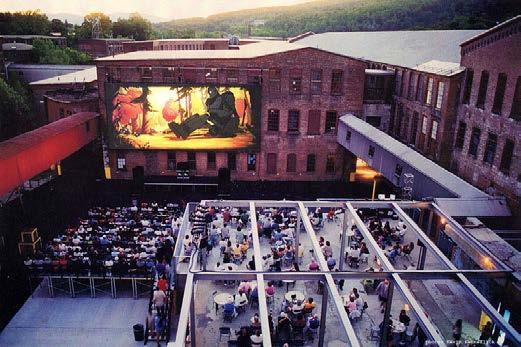
1 minute read
Case Study 2: A Crippled Industrial Park
MASS MoCA
North Adams, Massachusetts 1997
Advertisement
Tucked away in the Berkshire Mountains, 16 acres of industrialized land formed a web of stories dating back to the early 1700s. European colonists created a hub for makers after displacing the Mohican people from their ancestral homeland. Around the 1800s, businesses included shoemakers, a brickyard, sawmill, carpenters, hat makers, wagon manufacturers, and ironsmiths. Many of the businesses were employed by the government to create supplies for the Union Army. In 1860, a printing company named O. Arnold & Company installed equipment for printing cloth and supplied fabric for the soldier’s uniforms. By 1905, Arnold Print Works was one of the leading textile producers globally and the largest employer in North Adams. With the looming effects of the Great Depression, though, Arnold Print Works had to leave its North Adams location in 1942 and work out of smaller factories in the neighboring towns.
A flexible outdoor plaza was created to allow for events like concerts or film screenings and everyday activities like picnics or reading. (D.I.R.T.)
Sprague Electric Company bought the property and reoutfitted the inside of all the buildings to create a mega electronics plant. The company was working for the U.S. government, building components used in World War II. It was not until 1985 that the plant finally closed, leaving a large hole in the community. A year later, the Mayor approached the Williams College Museum of Art to house large art installations in the buildings. In 1988, funds were secured to retrofit the industrial campus, and in 1995, final designs were submitted for the first of three phases of the project.
The team of architects that brought the site back to life was Bruner/Cott. Extensive remediation work was done to preserve the existing structures, remove hazardous materials, and adapt the spaces to connect. In the end, the Massachusetts Museum of Contemporary Art (MASS MoCA) comprised 280,000 square feet of gallery space, performance venues, and commercial space and is still expanding and growing today.
There is little information recorded about Bargmann’s contribution to the project. Still, it is clear which aspects of the project are hers and her influence on retaining the site’s character. Her light touch is felt when walking around the large brick buildings. The most significant public space is a flexible event plaza at the center of the buildings that MASS MoCA can use for an outdoor theatre to screen movies, a concert, or just a place to picnic on a nice sunny day.










